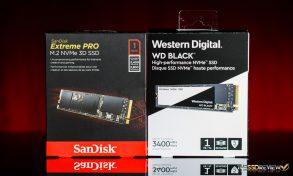PACKAGING, COMPONENTS, AND MORE
The packaging hasn’t changed that much from the first generation WD Black. This can be an issue for those looking to get the correct version when shopping online. The main differentiator for their second gen WD Black is the writing in the bottom left of the package that states the sequential read speed. Besides that, there is now a preview on the backside that allows you to see the SSD within. As for the SanDisk Extreme Pro, it’s very similar to the SanDisk Extreme Pro SATA’s packaging. Since this is the first iteration of an M.2 NVMe Extreme Pro and the packaging so obviously shows the drive on the front, it would be quite hard for consumers to mistake the SATA model for the latest M.2 model.
Once removed from the packaging, we can see that the stickers for each drive are applied in opposite directions. For those of you who are very particular about a label being upside down in your M.2 slot on your motherboard, this might be the deal breaker for one vs the other for you. Other than that, they are identical as mentioned earlier. Both also feature a black single-sided PCB. This is another plus for aesthetics and a plus for those who have the latest laptops in the market that require a single-sided PCB for M.2 storage.
Unlike what we have seen with other M.2 SSDs, WD has decided to mount their in-house built PCIe NVMe controller in the center of the M.2 stick (part #20-82-007011). This is positioning is part of Western Digital’s newest NVMe architecture and also partly for the best thermal performance. Developed in-house from the controller to NAND, Western Digital has created everything about this SSD from the ground up and it is optimized for faster client workloads.
This includes the latest SLC caching technology called nCache 3.0, built from SanDisk’s nCache 2.0. nCache 3.0 now leverages tiered caching that will switch from the SLC blocks and write directly to TLC in order to improve sustained write performance when the SLC cache runs out. Although, with the new 3D NAND and architecture, they are able to evacuate the SLC cache more aggressively, so the write workloads will mostly work through the cache.
Additionally, the use of Multi -Gear LDPC and Hardware ECC provide full SRAM and DRAM bit correction. Over the lifespan of the SSD, gear 1 will be utilized to correct errors and will be the fastest and most efficient, however, when the SSD reaches near the end of life it may start to use gears 1 & 2 as well as other methods to ensure your data is read correctly every time.
Now, let’s get on with our testing to see just how good this new architecture really is…
 The SSD Review The Worlds Dedicated SSD Education and Review Resource |
The SSD Review The Worlds Dedicated SSD Education and Review Resource | 

